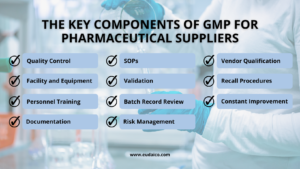
Decoding Certifications: GMP, GDP, & ISO Standards for Pharmaceutical Supplier Verification
In the pharmaceutical industry, certifications play a crucial role in ensuring product quality, safety, and compliance with industry standards. Healthcare entities and procurement managers must be aware of these standards and should choose suppliers that adhere to them, to ensure the quality and safety of the procured pharmaceutical products. Furthermore, these certifications can help to efficiently assess the quality and reliability of a pharmaceutical supplier in a time-constrained scenario, when procuring emergency medical supplies using special permits. Three essential certifications often associated with pharmaceutical supplier verification and quality control are Good Manufacturing Practices (GMP), Good Distribution Practices (GDP), and International Organization for Standardization (ISO) standards. Let us explore these certifications and their significance in supplier verification:
Good Manufacturing Practices (GMP)
What is GMP?
Good Manufacturing Practices (GMP) is a set of guidelines and quality assurance principles that places a strong emphasis on specific aspects and principles for pharmaceutical manufacturers, to ensure the production of safe and high-quality pharmaceutical products. GMP aims to minimize the risks associated with pharmaceutical manufacturing, ensuring that products are free from contamination, accurately labeled, and meet quality standards.
Key Components of GMP
Here are the key areas that GMP emphasizes for pharmaceutical manufacturers:

1. Quality Control: GMP requires that pharmaceutical manufacturers establish and maintain a robust quality control system. This involves testing and analysis of raw materials, intermediates, and finished products to verify their identity, purity, potency, and quality. It also includes in-process controls to monitor manufacturing processes.
2. Facility and Equipment: GMP mandates that manufacturing facilities and equipment be designed, maintained, and operated to minimize the risk of contamination, cross-contamination, and other potential hazards. This includes cleanliness, maintenance, and validation of equipment.
3. Personnel Training: GMP highlights the importance of adequately training and educating personnel involved in pharmaceutical manufacturing. This ensures that they are knowledgeable about GMP principles, safety procedures, and the specific requirements of their roles.
4. Documentation and Record-Keeping: Detailed and accurate documentation is a core GMP requirement. Pharmaceutical manufacturers must maintain comprehensive records of production, quality control, and distribution processes. This documentation is essential for traceability, accountability, and compliance with regulatory standards.
5. Standard Operating Procedures (SOPs): GMP encourages the development and adherence to SOPs for all critical processes. These procedures outline the steps to be followed, ensuring consistency in manufacturing and quality control.
6. Validation: Pharmaceutical manufacturers must validate critical processes and systems to ensure that they consistently produce products meeting predetermined specifications. This includes equipment validation, process validation, and cleaning validation.
7. Batch Record Review: Prior to release, a designated quality unit reviews and approves batch records to confirm that each batch has been produced and controlled in accordance with GMP requirements. This helps ensure product quality and safety.
8. Quality Risk Management: GMP promotes the use of risk assessment and management processes to identify and mitigate potential risks in manufacturing, quality control, and product safety. This proactive approach helps prevent issues before they occur.
9. Supplier and Vendor Qualification: Pharmaceutical manufacturers are responsible for verifying the quality and reliability of their suppliers and vendors. GMP dictates that suppliers should meet specific quality and safety standards.
10. Recall Procedures: Manufacturers must have robust procedures in place for initiating product recalls if quality or safety issues are identified. These procedures include notification of regulatory authorities and timely communication with customers.
11. Continuous Improvement: GMP encourages a culture of continuous improvement. Manufacturers are expected to regularly assess their processes, identify areas for enhancement, and implement changes to improve product quality and safety.
Pharmaceutical manufacturers must strictly adhere to these GMP principles to ensure that their products consistently meet high-quality standards, are safe for patient use, and comply with regulatory requirements. Therefore, when evaluating suppliers, healthcare organizations and procurers must look for GMP certification and compliance to ensure that the pharmaceutical products are manufactured as per the highest quality and safety standards.
Good Distribution Practices (GDP)
What is GDP?
Good Distribution Practices (GDP) are a set of guidelines and principles that emphasize the proper storage, transportation, and distribution of pharmaceutical products to ensure their quality, safety, and efficacy throughout the supply chain. GDP is primarily aimed at pharmaceutical distributors, wholesalers, and logistics companies. When it comes to ensuring quality control throughout the pharmaceutical supply chain, GMP and GDP complement each other, with the former highlighting manufacturing best practices and the latter focusing on quality-controlled distribution and logistics of medical goods.
Key Components of GDP
GDP includes the following guidelines for storage conditions, transportation methods, documentation, and other key aspects of the pharmaceutical distribution chain:

1. Storage Conditions: Proper storage conditions are critical to maintaining the quality of pharmaceutical products. GDP emphasizes that pharmaceutical distributors should store products at appropriate temperatures, humidity levels, and conditions specified by manufacturers. This includes refrigerated storage for products that require it.
2. Documentation and Record-Keeping: Detailed and accurate record-keeping is a key aspect of GDP. Distributors are required to maintain records of receipt, storage, and distribution activities, including information on product integrity, temperature monitoring, and any deviations from standard procedures.
3. Security and Access Control: GDP mandates that distributors implement robust security measures to prevent unauthorized access, theft, or tampering with pharmaceutical products. Access to storage areas should be restricted to authorized personnel only.
4. Personnel Training: Pharmaceutical distributors should ensure that their staff members are properly trained and knowledgeable about GDP requirements. This includes training on handling, storage, and transportation of pharmaceutical products.
5. Temperature Monitoring and Control: Temperature-sensitive pharmaceuticals must be stored and transported under controlled conditions. GDP emphasizes the use of temperature monitoring devices and alarms to ensure that products are kept within specified temperature ranges. In case of temperature excursions, distributors should have procedures for appropriate actions.
6. Handling and Transportation Practices: Pharma distributors must adhere to safe and sanitary handling practices to prevent contamination or damage to pharmaceutical products during loading, unloading, and transportation. Proper labeling and packaging are also crucial.
7. Product Recall Procedures: GDP requires distributors to have procedures in place for initiating product recalls if quality or safety issues are identified. Distributors should promptly communicate with manufacturers and regulatory authorities in case of recalls.
8. Validation and Qualification: Distributors should validate their storage and transportation processes to ensure that they consistently meet the required standards. This includes qualifications of vehicles, equipment, and facilities.
9. Good Documentation Practices (GDP): Distributors must maintain proper documentation throughout the distribution process, including records of shipments, storage conditions, and any deviations from standard procedures. These records are essential for traceability and accountability.
10. Compliance with Regulatory Requirements: GDP emphasizes compliance with local and international regulations, such as those from health authorities like the FDA and EMA. Distributors should stay up-to-date with regulatory changes and adapt their practices accordingly.
11. Risk Assessment and Mitigation: GDP encourages distributors to assess and manage risks associated with the distribution process, including risks related to theft, temperature excursions, or other potential issues that may affect product quality and safety.
12. Continuous Improvement: Like Good Manufacturing Practices (GMP), GDP encourages a culture of continuous improvement. Distributors should regularly assess their processes, identify areas for enhancement, and implement changes to improve the quality and safety of pharmaceutical products during distribution.
Compliance with GDP is crucial for pharmaceutical distributors to ensure that products remain safe, effective, and of high quality as they move through the supply chain. Therefore, procurement managers of healthcare organizations must check for GDP compliance when vetting a pharmaceutical supplier for their product needs.
International Organization for Standardization (ISO) Standards
What are ISO Standards?
ISO is an international body that develops and publishes standards for various industries, covering a wide range of aspects, including quality management, environmental management, and information security. ISO standards help organizations improve processes, products, and services while ensuring consistency, efficiency, and quality.
Key Components of ISO standards:
ISO standards vary depending on the specific certification but typically include documentation, process control, risk management, and continuous improvement. ISO 9001 is a relevant standard that all pharmaceutical suppliers must abide by.
ISO 9001: Quality Management System (QMS): ISO 9001 is a widely recognized standard that sets the requirements for a quality management system. It is applicable to organizations of all types and sizes, including pharmaceutical suppliers. ISO 9001 emphasizes customer satisfaction, process improvement, and the consistent delivery of quality products and services.
Your pharmaceutical suppliers must possess ISO certifications relevant to the industry to demonstrate their commitment to quality, environmental responsibility, or other specific aspects of their operations. Do consider these certifications during supplier evaluation.
Bottomline
Supplier verification is a critical aspect of ensuring a robust pharmaceutical supply chain. Healthcare organizations need to assess their suppliers’ adherence to relevant certifications like GMP, GDP, or ISO standards to mitigate risks and maintain product quality and safety.
At Eudaico we have an unwavering commitment to quality, which we uphold by adherence to the Good Distribution Practices advocated by the WHO and careful selection of manufacturing facilities accredited by USFDA, EMEA, PIC/s, and WHO. Our stringent commitment to quality extends to our robust and efficient ISO 9001:2015 certified quality management systems, ensuring the delivery of top-tier pharmaceuticals to various global regions.
If you are a healthcare organization seeking a dependable partner for pharmaceutical supplies, contact us today!



